

Anthemis. ++ Automatic - Your Smart Driving Assistant. Data for social good. Data is around you (not interface) Multi-factor authentication. Environment / objects have data. Biologically inspired. Lumigenix - Genetic Testing for Health, Disease and Ancestry. CNS » Introduction. Genetic Testing for Health, Disease & Ancestry; DNA Test - 23andMe.
++ carole kushnir : 23andMe Stories. Electroencephalography. Life Technologies Corporation. DeCODEme - Empowering prevention. Calculate genetic risk for diseases, DNA research for personal and family health and ancestry. A Vision for Personalized Medicine. Leroy Hood has been at the center of a number of paradigm shifts in biology.
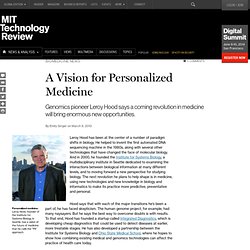
He helped to invent the first automated DNA sequencing machine in the 1980s, along with several other technologies that have changed the face of molecular biology. And in 2000, he founded the Institute for Systems Biology, a multidisciplinary institute in Seattle dedicated to examining the interactions between biological information at many different levels, and to moving forward a new perspective for studying biology. Augmented Reality. Health focused genetic testing and analysis; DNA test - Navigenics. Review of the Lumigenix “Comprehensive” personal genome service.
This is the first of a new format on Genomes Unzipped: as we acquire tests from more companies, or get data from others who have been tested, we’ll post reviews of those tests here.
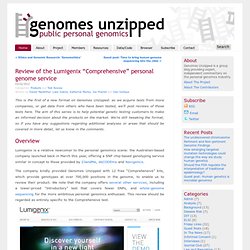
The aim of this series is to help potential genetic testing customers to make an informed decision about the products on the market. We’re still tweaking the format, so if you have any suggestions regarding additional analyses or areas that should be covered in more detail, let us know in the comments. Overview. Genetic Testing. Software to develop. The Wearable, Implantable, Personalized Future Of Medicine. As a child, you could always count on it, even after--especially after--you struck out playing T-ball, forgot your only line in the grade school play, and came home with chalk in your nose because you took the schoolyard dare.
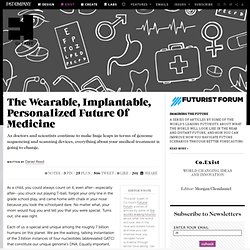
No matter what, your mom would hug you and tell you that you were special. Turns out, she was right. Each of us is special and unique among the roughly 7 billion humans on this planet. We are the walking, talking instantiation of the 3 billion instances of four nucleotides (abbreviated GATC) that constitute our unique genome’s DNA. Biological network. A biological network is any network that applies to biological systems.
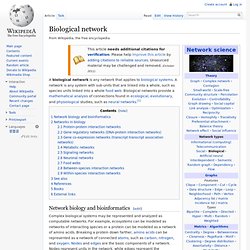
A network is any system with sub-units that are linked into a whole, such as species units linked into a whole food web. Biological networks provide a mathematical analysis of connections found in ecological, evolutionary, and physiological studies, such as neural networks.[1] Nanotechnology. Nanotechnology ("nanotech") is the manipulation of matter on an atomic, molecular, and supramolecular scale.
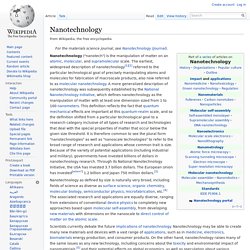
The earliest, widespread description of nanotechnology[1][2] referred to the particular technological goal of precisely manipulating atoms and molecules for fabrication of macroscale products, also now referred to as molecular nanotechnology. A more generalized description of nanotechnology was subsequently established by the National Nanotechnology Initiative, which defines nanotechnology as the manipulation of matter with at least one dimension sized from 1 to 100 nanometers. This definition reflects the fact that quantum mechanical effects are important at this quantum-realm scale, and so the definition shifted from a particular technological goal to a research category inclusive of all types of research and technologies that deal with the special properties of matter that occur below the given size threshold.
Origins[edit] Nanomedicine. Nanomedicine is the medical application of nanotechnology.[1] Nanomedicine ranges from the medical applications of nanomaterials, to nanoelectronic biosensors, and even possible future applications of molecular nanotechnology.
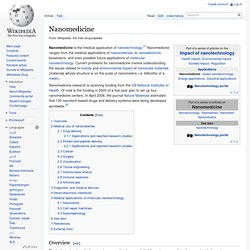
Current problems for nanomedicine involve understanding the issues related to toxicity and environmental impact of nanoscale materials (materials whose structure is on the scale of nanometers, i.e. billionths of a meter). Nanomedicine research is receiving funding from the US National Institutes of Health. Of note is the funding in 2005 of a five-year plan to set up four nanomedicine centers. In April 2006, the journal Nature Materials estimated that 130 nanotech-based drugs and delivery systems were being developed worldwide.[2]
IBM: In the next 5 years computers will learn, mimic the human senses. IBM today issued its seventh annual look at what Big Blue researchers think will be the five biggest technologies for the next five years. In past prediction packages known as "IBM 5 in 5" the company has had some success in predicting the future of password protection, telemedicine and nanotechnology. The IBM 5 in 5 research is based collective trends as well as emerging technologies from IBM's R&D labs around the world.
This year's research points to the development of what IBM calls a new generation of machines that will learn, adapt, sense and begin to experience the world as humans do through hearing, sight, smell, touch and taste. Research: A new era of computing: cognitive systems - United States. ++ SyNAPSE: a cognitive computing project from IBM Research - United States. IMW14671USEN.PDF (application/pdf Object) ++ Eidos - Sensory augmentation equipment (full version) Steve Mann - Transhumanism Wiki. File:Lightspace-wearcomp-lightcomb.jpg Steve Mann (born in Hamilton, Ontario),[1] is a tenured professor at the Department of Electrical and Computer Engineering at the University of Toronto.
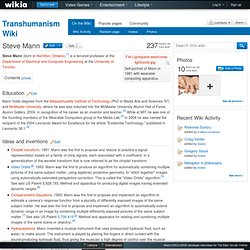
Education Edit. Steve Mann. Steven Mann (born 1962) is a researcher and inventor best known for his work on computational photography, particularly wearable computing and high dynamic range imaging.

Early life and education[edit] He is also General Chair of the IEEE International Symposium on Technology and Society, Associate Editor of IEEE Technology and Society, is a licensed Professional Engineer, and Senior Member of the IEEE.[6] Career[edit] Mann is a tenured professor at the Department of Electrical and Computer Engineering, with cross-appointments to the Faculty of Arts and Sciences, and Faculty of Forestry, at the University of Toronto, and is a Professional Engineer licensed through Professional Engineers Ontario. He is also General Chair of the IEEE International Symposium on Technology and Society and Associate Editor of IEEE Technology and Society.[6] Steve Mann's Blog. Experimental headsets let you see the invisible, hear the inaudible. Students at the Royal College of Arts in London have designed headsets capable of augmenting the sights and sounds around us to enhance our sensory experiences.
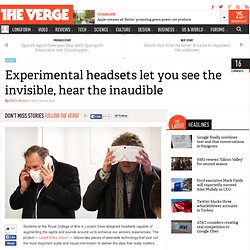
The project — called Eidos Vision — utilizes two pieces of wearable technology that pick out the most important audio and visual information to deliver the data that really matters. Eidos Vision is worn like a pair of goggles and is designed to produce an effect similar to a long-exposure photo, helping to identify patterns of movement in real time. Eidos Audio forms a mask that covers the ears and the mouth, targeting both the outer and inner ear (the latter via bone conduction), delivering audio directly inside your head. Both headsets use a computer to process data, highlighting previously invisible or inaudible details. The project's creators believe the Eidos prototypes could be used by sportspeople to analyze their performance or to assist healthcare organizations in improving the sensory perception of their patients.
Brain–computer interface. A brain–computer interface (BCI), sometimes called a mind-machine interface (MMI), direct neural interface (DNI), synthetic telepathy interface (STI) or brain–machine interface (BMI), is a direct communication pathway between the brain and an external device.
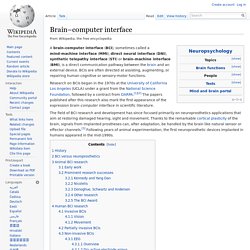
BCIs are often directed at assisting, augmenting, or repairing human cognitive or sensory-motor functions. Research on BCIs began in the 1970s at the University of California Los Angeles (UCLA) under a grant from the National Science Foundation, followed by a contract from DARPA.[1][2] The papers published after this research also mark the first appearance of the expression brain–computer interface in scientific literature.
Neural Impulse Actuator. On June 1, 2012 a post was made on the official forums, asking about the NIAs future,[2] the reply being, "It [the NIA] was spun out into a different company as a side-effect of OCZ's IPO and that company is BCInet. ".[3] Name[edit] Shortkeys system[edit] Control over the computer in either desktop or gaming environments is done by binding keys to different zones within as many as three vertical joysticks. Each joystick can be divided into several zones based on thresholds and each zone within each joystick can be bound to a keyboard key.
Each keystroke can further be assigned to several modes, including single keystroke, hold, repeat and dwell, which allows full plasticity with respect to configuration of the NIA for any application. Psychokinesis. Artist conception of alleged spontaneous psychokinesis from 1911 French magazine La Vie Mysterieuse. PK experiments have historically been criticized for lack of proper controls and repeatability.[13][15][16][17] Furthermore, some experiments have created illusions of PK where none exists, and these illusions depend to an extent on the subject's prior belief in PK.[18][19] Etymology[edit] The word psychokinesis, a portmanteau of the Greek language words ψυχή ("psyche"), meaning mind, soul, spirit, or breath; and κίνησις ("kinesis"), meaning motion, movement,[1][2] was coined in 1914 by American author Henry Holt in his book On the Cosmic Relations.[20][21][22] The term was later adopted by American parapsychologist J.
B. Rhine in 1934 in connection with experiments that were conducted to determine if a person could influence the outcome of falling dice.[8][23] Belief[edit] ++ See Inside Your Head with Biocasting. See Inside Your Head A Project Utilizing Mobile EEG for Custom Brain Visualization and City Mapping A sample EEG brainscan Mobile EEG System.
"See Inside Your Head" is an arts project based on bio-casting - using your own brainwaves to arrive at a deeper understanding of yourself and your environment. This project is entirely funded by you, through the infrastructure Kickstarter.com, an innovative funding source for public arts. Please join our mailing list so that we can notify you when the project is available for participation. Mind_and_Music. Mindflex Hack Turns Brain Waves Into Music. NeuroSky - Brainwave Sensors for Everybody. The University Of Wollongong and ADHD. ++ Neurocog - : Neurocog. Uow128670.pdf (application/pdf Object) Uow126870.pdf (application/pdf Object)
NeuroCog and the University of Wollengong on ADHD. Necomimi Store. A tour of some of Japan’s coolest tech innovations, by Dentsu’s Kei Shimada. The Force Trainer. NeuroSky sticks EEG sensors in a golf visor, sells it to Japanese athletes (video) NeuroSky Partner B-Bridge International, Inc. announces BrainAthlete Tokyo, Japan, December 21, and San Jose, CA, USA, December 20, 2010 - B-Bridge International proudly unveils the first brainwave athletic trainer. Neurocogsolutions.com. Samsung works on mind-control tablet. 23 April 2013Last updated at 12:21 ET. National Science Foundation. Nsf.gov - National Science Foundation - US National Science Foundation (NSF)
Computing - Discoveries. RTPIS. Brain2grid. TEDxGeorgiaTech - Steve Potter - NeuroEngineering: Neuroscience - Applied. ++ EPOC Features. Brain Computer Interface (BCI) for $299. Symbiosis International University. The society was established in 1971 by Padmashree S. Symbiosis Institute of Computer Studies & Research. SICSR, celebrating its 25th year was one of the first Institutes in Maharashtra to offer high quality computer education. + Shyam Sankar: The rise of human-computer cooperation. WTC Names Arrangement Tool. Human-Computer Symbiosis: 9/11 Memorial Name Layout. Man-Computer Symbiosis. Lever up.
Human Computer Interaction. Human Computer Interface. Advances in the Human Computer Interface. Behavioral Predictive Interfaces. Predicting the effects of in-car interface use ondriver performance. EMOTIONAL AND BEHAVIORAL RESPONSE TO AUDITORY ICONS AND EARCONS IN DRIVER-VEHICLE INTERFACES. Acceptance of Future Persuasive In-Car Interfaces Towards a More Economic Driving Behaviour. Graphics.cs.columbia.edu/courses/mobwear/resources/maeda-iswc02.pdf. Predictive Model of Human Performance w Scrolling Hierarchical Lists 2008. The Psychology of Google Glass.
++ Human Computer Interaction. The Wearable, Implantable, Personalized Future Of Medicine. The future of human-computer interaction. Human Computer Interaction Design in India. User Experience, Usability, Forums, Articles, Society, Firms, Schools, Groups, Books, etc. ++ The Next Generation in Human Computer Interfaces. Pattie Maes and Pranav Mistry demo SixthSense. Pranav Mistry: The thrilling potential of SixthSense technology.
University of Maryland, Human-Computer Interaction Lab.
HCI video - Past Present Future. HCI video. HCI as Agents of Change. Living Without Parental Controls: The Future of HCI. The Demon and Engelbart’s Children. Structure. "Meatware" or "wetware" 'Terminator-style' killer robots are almost a reality, warn campaigners. Digital Wildfires (implications) BIN (parked misc etc) Wrap up of Important Links.